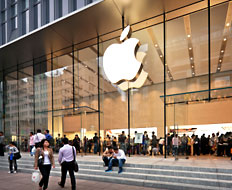When Steve Jobs passed away in October, many questioned whether or not Apple would be able thrive without his leadership. But when the company announced in January that its first-quarter sales had risen 73 percent to $46 billion, it was clear to everyone that Jobs had left the company in good shape.
There are many reasons Apple is performing so well, and quick serves can learn a lesson or two from its success to make their own businesses thrive.
For the most applicable lesson from Apple’s dominance, quick-serve operators should look no further than when the company launched its iPhone 4 in mid-2010 and a slight mistake risked the company’s entire reputation. You may remember there were some glitches with the smartphone’s external antenna, and it dropped calls when the phone was held a certain way.
Jay Greene, author of Design Is How It Works, wrote in the Wall Street Journal about Apple’s iPhone 4 situation and how the company was able to fix the problem, avoid disaster, and keep business booming. Here are some important points Greene makes, with my take on why they are important for quick-service restaurants.
Focus On Quality and Generate Goodwill. Greene says Apple’s fierce focus on designing cool products pays off in more ways than just sales. Even with its antenna problems, customers snapped up iPhone 4s like they were a limited edition and bought millions of them.
“How is that possible?” Greene asks in his article. “Because Apple’s decade-long focus on design has bought it significant goodwill among consumers. … Apple’s consumers are willing to cut the company some slack because of its reputation.”
Most restaurants aren’t struggling with the kind of iPhone trouble Apple had, but they are slogging through a nasty recession. Where Apple zeroed in on excellence in design, eateries need to aim for the customer service bull’s eye. Focus on providing quality service and your customers are more likely to repay you with goodwill that comes in the form of continued dining at your establishment. They may just give you a break and return to eat even though economic times are tough.
You can achieve this by building a reputation for a wonderful, fast dining experience that’s underpinned with stellar service.
The Customer Experience is Like Gold. Jobs believed that “it’s a mistake to think that design is merely about aesthetics,” Green writes. Greene offers the following quote from Jobs: “That’s not what we think design is. It’s not just what it looks like and feels like. Design is how it works.”
It seems Greene and Jobs are talking about the customer experience. An iPhone is so well designed inside and out that customers love to use it. Think of it from a restaurant perspective: with a smile, an employee makes a guest his drink in a timely manner and the drink is very good. The customer likes what he sees (the drink made skillfully and timely) and how it tastes (it’s a delicious iced-coffee beverage). In other words, that’s a good design of great service.
But what’s even more important is how the design works. How did that excellent service make the customer feel? How does all the service at the restaurant make the customer feel? Is the service impressive enough that the customer remembers it the next time he decides to eat out? The whole point of fantastic service is to create a great dining experience that brings customers back again and again. You want them to fanatically love eating at your restaurant.
Goodwill Has a Long Shelf Life. One of these years, this awful recession will be gone. Times will get better. Revenues will improve. But we all know that another recession is potentially lurking somewhere down the road. What kind of relationship will your restaurant have with its customers if that day arrives? If you’re building service-based goodwill, the relationship should be a sound one and your establishment just might survive yet again.
Greene points to Apple as the recipient of long-shelf-life goodwill. Two years before the iPhone problems, he writes, Apple faced criticism when it had problems with its MobileMe Service, which synchronized e-mail, calendar, and contact information across multiple devices.
For Apple to have those bumps along the road within two years and still ride a groundswell of goodwill—one that nearly two years later has led the company to record profits—is amazing.
The same thing can happen for quick serves if they work to build goodwill from their own customers through excellent service and a top-notch customer experience.

